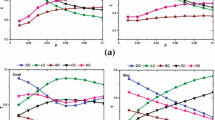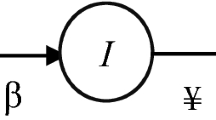Abstract
Influential spreaders identification in social networks contributes to optimize the use of available resources and ensure the more efficient spread of information. In contrast to common belief that highly connected or core located users are most crucial spreaders, this paper shows that both user’s local and global structural properties matter in information diffusion. We propose a new metric, social circle broadness, to measure a user’s information spreading influence by qualitatively combining the two above properties. Firstly, a definition of social circle diversity is introduced to measure the dispersion extent of a user’s friends distribution in the network. Based on it, a method to calculate each user’s local social circle broadness is presented. Preliminary experiments on a coauthor dataset demonstrate the effectiveness of social circle broadness in information diffusion. Furthermore, a social circle weighted PageRank (SCWPR) algorithm is proposed to iteratively rank each user’s global social circle broadness. We conduct extensive comparison experiments against six state-of-the-art baseline methods on four real social network datasets. The results show that SCWPR outperforms all of them for influential spreaders identification in information propagation.
Similar content being viewed by others
References
Aditya, P., Scott, C.: Identifying topical authorities in microblogs. In: Proceedings of the 4th ACM International Conference on Web Search and Data Mining (WSDM’2011)
Amitl, G., Francesco, B., Laks, V.S.L.: Learning influence probabilities in social networks. In: Proceedings of the 3th ACM International Conference on Web Search and Data Mining (WSDM’2010)
Anderson, R.M., May, R.M., Anderson, B.: Infectious Disease of Humans: Dynamic and Control. Oxford Science, Oxford (1992)
Baumes, J., Goldberg, M., Krishnamoorthy, M., Magdon-Ismail, M., Preston, N.: Finding communities by clustering a graph into overlapping subgraphs. In: IADIS International Conference on Applied Computing (2005)
Blondel, V.D., Guillaume, J.L., Lambiotte, R., Lefebrve, E.: Fast unfolding communities in large networks. In: Journal of Statistical Mechanics: Theory and Experiment, P10008 (2008)
Brandes, U.: On variants of shortest-path betweenness centrality and their generic computation. Soc. Networks 30, 136C145 (2008)
Burt, R.S.: Structure Holes: the Social Structure of Competition. Harvard University Press, Massachusetts (1992)
Cao, J., Wu, Z.A., Wu, J.J., Xiong, H.: SAIL: summation-bAsed incremental learning for information-theoretic text clustering. IEEE Trans. Syst. Man Cybern. B 43(2), 570–584 (2013)
Carmi, S., Havlin, S., Kirkpatrick, S., Shir, Y., Shir, E.: A model of Internet topology using k-shell decomposition. Proc. Natl. Acad. Sci. U.S.A. 104, 11150–11154 (2007)
Chung, K.S.K., Hossain, L.: Network structure, position, ties and ICT use in distributed knowledge-intensive work. In: Proceedings of the 2008 ACM Conference on Computer Supported Cooperative Work (CSCW’2008)
Clauset, A., Newman, M.E.J., Moore, C.: Finding community structure in very large networks. Phys. Rev. E 70, 066111 (2004)
Cui, Y., Pei, J., Tang, G.T., Luk, W.S., Jiang, D.X., Hua, M.: Finding email correspondents in online social networks. World Wide Web J. 16(2), 195–218 (2013)
Diekmann, O., Heesterbeek, J.A.P.: Mathematical Epidemiology of Infectious Diseases: Model Building, Analysis and Interpretation. Wiley Series in Mathematical & Computational Biology, New York (2000)
Endres, D.M., Schindelin, J.E.: A new metric for probability distributions. IEEE Trans. Inf. Theory 49(7), 1858–1860 (2003)
Fortunato, S.: Community detection in graphs. Phys. Rep. 486(3–5), 75–174 (2010)
Goh, K.C.I., Oh, E., Kahng, B., Kim, D.: Betweenness centrality correlation in social networks. Phys. Rev. E, 61 (2003)
Goldenberg, J., Han, S., Lehmann, D.R., Hong, J.W.: The role of hubs in the adoption. J. Mark. 73, 1–43 (2011)
Guimerà, R., Sales-Pardo, M., Amaral, L.A.N.: Classes of complex networks defined by role-to-role connectivity profiles. Nat. Phys. 3, 63–69 (2007)
Haythornthwaite, C.: Social network analysis: an approach and technique for the study of information exchange. Libr. Inf. Sci. Res. 18(4), 323–342 (1996)
Hopcroft, J., Lou, T., Tang, J.: Who will follow you back? reciprocal relationship prediction. In: Proceedings of the 20th ACM Conference on Information and Knowledge Management (CIKM’2011), pp. 1137C–1146 (2011)
Hui, L., Sourav, S.B., Aixin, S.: CASINO: towards conformityaware scoial influence analysis in online social networks. In: Proceedings of the 20th ACM International Conference on Information and Knowledge Management (CIKM’2011)
Jie, T., Jing, Z., Ruoming, J.: Topic level expertise search over heterogeneous networks. Mach. Learn. 82, 211–237 (2011)
Keeling, M.J., Rohani, P.: Modeling Infectious Diseases in Humans and Animals. Princeton University Press, Princeton (2008)
Kempe, D., Kleinberg, J., Tardos, E.: Maximizing the spread of influence through a social network. In Proceedings of the 9th ACM SIGKDD Internatioanl Conference on Knowledge Discovery and Data Mining (KDD’2003), pp. 1175C–1180 (2003)
Kendall, M.: A new measure of rank correlation. Biometrika 30(1–2), 81–93 (1938)
Kitsak, M., Gallos, L.K., Havlin, S., Liljeros, F., Muchnik, L., Stanley, H.E., Makse, H.A.: Identifying influential spreaders in complex networks. Nat. Phys. 6, 888C893 (2010)
Lou, T., Tang, J., Hopcroft, J., Fang, Z., Ding, X.: Learning to predict reciprocity and triadic closure in social networks. In: TKDD (2013)
Michael, G.N., Ching-man, A.Y., Nicholas, G., Christoph, M., Nigel, S.: Telling experts from spammers: expertise ranking in folksonomies. In: Proceedings of the 32th Annual International ACM SIGIR Conference (SIGIR’2011)
Musial, K., Kazienko, P.: Social networks on the internet. World Wide Web J. 16(1), 31–72 (2013)
Nitin, A., Huan, L., Lei, T.: Identifying the influential bloggers in a community. In: Proceedings of the 1th ACM International Conference on Web Search and Data Mining (WSDM’2008)
Page, L., Brin, S., Motwani, R., Winograd, T.: The PageRank citation ranking: bringing order to the web. In: Proceedings of the 7th International World Wide Web Conference (WWW’1998).
Palla, G., Derenyi, I., Farkas, I., Vicsek, T.: Uncovering the overlapping community structure of complex networks in nature and society. Nature 435, 814 (2005)
Pastor-Satorras, R., Vespignani, A.: Epidemic spreading in scale-free networks. Phys. Rev. Lett. 86, 3200–3203 (2001)
Pastor-Satorras, R., Vespignani, A.: Epidemic spreading in scalefree networks. Phys. Rev. Lett. 3200–3203, 86 (2002)
Tang, J., Zhang, J., Yao, L.M., Li, J.Z., Zhang, L., Su, Z.: ArnetMiner: extraction and mining of academic social networks. In: Proceedings of the 14th ACM SIGKDD International Conference on Knowledge Discovery and Data Mining (SIGKDD’2008)
Tang, J., Zhang, D., Yao, L.M.: Social network extraction of academic researchers. In: Proceedings of 2007 IEEE International Conference on Data Mining (ICDM’2007)
Ugander, J., Backstrom, L., Marlow, C., Kleinberg, J.: Structural diversity in social contagion. Proc. Natl. Acad. Sci. U. S. A. 109(16), 5962–5966 (2012)
Wei, F., Qian, W.N., Wang, C., Zhou, A.Y.: Detecting overlapping community structures in networks. World Wide Web J 12(2), 235–261 (2009)
Weng, J.S., Lim, E.P., Jiang, J.: TwitterRank: finding topic sensitive influential twitterers. In: Proceedings of the 3th ACM International Conference on Web Search and Data Mining (WSDM’2010)
Zhang, R.C., Tran, T., Mao, Y.Y.: Opinion helpfulness prediction in the presence of words of few mouths. World Wide Web J. 15(2), 117–138 (2012)
Author information
Authors and Affiliations
Corresponding authors
Rights and permissions
About this article
Cite this article
Wang, S., Wang, F., Chen, Y. et al. Exploiting social circle broadness for influential spreaders identification in social networks. World Wide Web 18, 681–705 (2015). https://doi.org/10.1007/s11280-014-0277-1
Received:
Revised:
Accepted:
Published:
Issue Date:
DOI: https://doi.org/10.1007/s11280-014-0277-1




